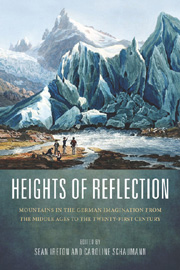 Heights of Reflection
Heights of Reflection Book contents
- Frontmatter
- Contents
- Acknowledgments
- Introduction: The Meaning of Mountains: Geology, History, Culture
- Prelude: Classical Mountain Landscapes and the Language of Ascent
- Part I First Forays: Mountain Exploration and Celebration from the Middle Ages to the Eighteenth Century
- Part II Beckoning Heights: Summits Near and Far in the Nineteenth Century
- Fascinating Voids: Alexander von Humboldt and the Myth of Chimborazo
- From Eros to Thanatos: Hiking and Spelunking in Ludwig Tieck's Der Runenberg
- Geology, Mountaineering, and Self-Formation in Adalbert Stifter's Der Nachsommer
- “An Apparition from Another World”: The Mountains of the Moon and Kilimanjaro from the Perspective of Nineteenth-Century Germany
- Part III Modern Expeditions and Evocations: Climbing from the Twentieth into the Twenty-First Century
- Works Cited
- Notes on the Contributors
- Index
From Eros to Thanatos: Hiking and Spelunking in Ludwig Tieck's Der Runenberg
from Part II - Beckoning Heights: Summits Near and Far in the Nineteenth Century
Published online by Cambridge University Press: 05 February 2013
- Frontmatter
- Contents
- Acknowledgments
- Introduction: The Meaning of Mountains: Geology, History, Culture
- Prelude: Classical Mountain Landscapes and the Language of Ascent
- Part I First Forays: Mountain Exploration and Celebration from the Middle Ages to the Eighteenth Century
- Part II Beckoning Heights: Summits Near and Far in the Nineteenth Century
- Fascinating Voids: Alexander von Humboldt and the Myth of Chimborazo
- From Eros to Thanatos: Hiking and Spelunking in Ludwig Tieck's Der Runenberg
- Geology, Mountaineering, and Self-Formation in Adalbert Stifter's Der Nachsommer
- “An Apparition from Another World”: The Mountains of the Moon and Kilimanjaro from the Perspective of Nineteenth-Century Germany
- Part III Modern Expeditions and Evocations: Climbing from the Twentieth into the Twenty-First Century
- Works Cited
- Notes on the Contributors
- Index
Summary
As Michel Foucault tells us, “the disciplinary space is always basically cellular” as “solitude [is] necessary to both body and soul, according to a certain asceticism.” Martin Heidegger was well aware of this as he took refuge in his mountain hut in Todtnauberg, whose solitude far away from the city was deeply connected to the harmony of his work world and essential to his roots in the Alemannic-Swabian soil. Heidegger saw the link between the German Volk and its home soil as deeply rooted in the autochthony, the Bodenständigkeit, of ancient Greece. To his mind, these chthonic roots of Greek antiquity constituted the very being of its people in the city of Athens. He understood Athens, the polis, as etymologically derived from pelein, being. He also regarded his own roots and those of Germany as connected specifically with the Black Forest. In this regard he differed substantially from Greek perceptions of places outside the city (especially the mountains) as a locus daemonis, an uncivilized space in which the Sein (pelein) of human Dasein loses its contours.
In the wake of German Enlightenment and its various forms of bourgeois self-constraint based on rationality and rationalism, the mountains are a terrain in which subconscious, repressed (verborgene) desires are unearthed (geborgen) and come to the surface. This occurs especially in Romantic literature, where the repressed emerges from the subterranean domain of the mountains, their cavernous interior, mineshafts, and caves.
- Type
- Chapter
- Information
- Heights of ReflectionMountains in the German Imagination from the Middle Ages to the Twenty-First Century, pp. 176 - 192Publisher: Boydell & BrewerPrint publication year: 2012


